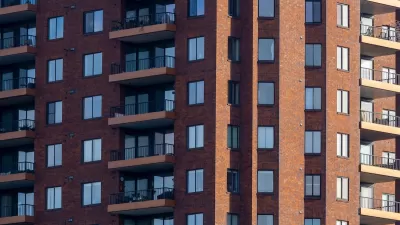Americans relying on federal rental assistance are struggling harder than ever to find affordable housing, braving years-long wait lists and reluctant landlords.

Writing in Bloomberg CityLab, Sarah Holder and Airielle Lowe describe how soaring rents have hit housing voucher recipients particularly hard as the housing shortage makes finding housing much more competitive. “Already plagued by years-long wait times, those who receive so-called Section 8 housing choice vouchers are struggling to use them to find apartments with rents at or near records nationwide.”
As Holder and Lowe explain, “The government defines anyone who spends more than 30% of their income on housing as “cost burdened,” which constituted over 40% of renter households, or 19 million, from 2017-2021, according to Census Bureau data released in December.” But vouchers can only be used for apartments at “fair market rent,” a measure usually calculated for an entire metro area, making some neighborhoods “completely unaffordable” for voucher holders.
Recent changes in how fair market rent is calculated should help voucher holders access more housing in more neighborhoods. When HUD started incorporating private housing-market data into their calculations, “Fiscal year 2023’s fair market rents, in effect as of October 2022, jumped a record average of 10% across the country.”
Voucher recipients face other challenges. For example, “There are no federal housing protections against sources of income discrimination, so in most jurisdictions, landlords aren’t mandated to rent to Section 8 tenants.”
FULL STORY: Relentless Rents Leave Few Choices for Americans Relying on Assistance

Alabama: Trump Terminates Settlements for Black Communities Harmed By Raw Sewage
Trump deemed the landmark civil rights agreement “illegal DEI and environmental justice policy.”

Study: Maui’s Plan to Convert Vacation Rentals to Long-Term Housing Could Cause Nearly $1 Billion Economic Loss
The plan would reduce visitor accommodation by 25% resulting in 1,900 jobs lost.

Why Should We Subsidize Public Transportation?
Many public transit agencies face financial stress due to rising costs, declining fare revenue, and declining subsidies. Transit advocates must provide a strong business case for increasing public transit funding.

Paris Bike Boom Leads to Steep Drop in Air Pollution
The French city’s air quality has improved dramatically in the past 20 years, coinciding with a growth in cycling.

Why Housing Costs More to Build in California Than in Texas
Hard costs like labor and materials combined with ‘soft’ costs such as permitting make building in the San Francisco Bay Area almost three times as costly as in Texas cities.

San Diego County Sees a Rise in Urban Coyotes
San Diego County experiences a rise in urban coyotes, as sightings become prevalent throughout its urban neighbourhoods and surrounding areas.
Urban Design for Planners 1: Software Tools
This six-course series explores essential urban design concepts using open source software and equips planners with the tools they need to participate fully in the urban design process.
Planning for Universal Design
Learn the tools for implementing Universal Design in planning regulations.
Smith Gee Studio
Alamo Area Metropolitan Planning Organization
City of Santa Clarita
Institute for Housing and Urban Development Studies (IHS)
City of Grandview
Harvard GSD Executive Education
Toledo-Lucas County Plan Commissions
Salt Lake City
NYU Wagner Graduate School of Public Service





























